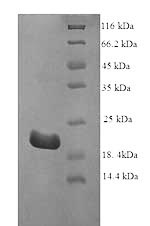Interferon tau-1 (IFNT1) is a crucial cytokine involved in maternal recognition of pregnancy in ruminant ungulates. It is primarily secreted by mononuclear trophectoderm cells of peri-implantation conceptuses into the uterine lumen [1][2]. Initially known as ovine trophoblast protein (oTP-1) or trophoblastin, IFNT1 was later named interferon tau (IFNT) due to its unique developmental expression by trophectoderm and its similarity to other Type I interferons [3][4]. IFNT1 is synthesized and secreted by the trophectoderm of blastocysts, serving as the initial fetal signal required for maternal recognition of pregnancy [5]. It acts on endometrial cells in a paracrine manner, inhibiting the transcription of certain genes and suppressing the release of luteolytic prostaglandin F2α, thereby maintaining corpus luteum function [6][7]. IFNT1 plays a critical role in preventing luteolysis and supporting early pregnancy [8][9].
The biological activity of IFNT1 is essential for establishing and maintaining pregnancy in ruminants. It is a major conceptus protein that initiates maternal recognition of pregnancy and exerts an antiluteolytic effect crucial for the continuation of pregnancy [10][11]. IFNT1's unique properties, such as its massive production by trophectoderm cells and potent antiviral and antiproliferative effects, distinguish it as a distinct Type I interferon subtype with significant biological functions [12]. The cytokine's actions on the endometrium and its ability to modulate gene expression highlight its importance in the complex interactions between the conceptus and the maternal reproductive system [6][7][13].
References:
[1] . Sakurai, A. Sakamoto, Y. Muroi, H. Bai, K. Nagaoka, K. Tamuraet al., "Induction of endogenous interferon tau gene transcription by cdx2 and high acetylation in bovine nontrophoblast cells1", Biology of Reproduction, vol. 80, no. 6, p. 1223-1231, 2009. https://doi.org/10.1095/biolreprod.108.073916
[2] M. Kim, H. Lim, J. Lee, S. Park, J. Won, & H. Kim, "Analysis of bovine interferon-tau gene subtypes expression in the trophoblast and non-trophoblast cells", Journal of Animal Reproduciton and Biotechnology, vol. 33, no. 4, p. 195-203, 2018. https://doi.org/10.12750/jet.2018.33.4.195
[3] F. Bazer and W. Thatcher, "Chronicling the discovery of interferon tau", Reproduction, vol. 154, no. 5, p. F11-F20, 2017. https://doi.org/10.1530/rep-17-0257
[4] M. Conde-Hinojosa, J. Gallegos-Sánchez, G. Hernández, J. Salazar-Ortiz, F. Clemente-Sánchez, & C. Cortez-Romero, "Involvement of the interferon tau gene in maternal recognition of gestation in sheep", Agro Productividad, 2021. https://doi.org/10.32854/agrop.v14i8.2039
[5] Y. N, W. Pc, H. Zd, G. Ff, L. Yang, C. Mset al., "Expression of interferon‐tau mrna in bovine embryos derived from different procedures", Reproduction in Domestic Animals, vol. 44, no. 1, p. 132-139, 2009. https://doi.org/10.1111/j.1439-0531.2007.01009.x
[6] J. Lee, J. Stanley, J. McCracken, S. Banu, & J. Arosh, "Intrauterine coadministration of erk1/2 inhibitor u0126 inhibits interferon tau action in the endometrium and restores luteolytic pgf2alpha pulses in sheep1", Biology of Reproduction, vol. 91, no. 2, 2014. https://doi.org/10.1095/biolreprod.113.111872
[7] . Sakurai, H. Bai, R. Bai, D. Sato, M. Arai, K. Okudaet al., "Down‐regulation of interferon tau gene transcription with a transcription factor, eomes", Molecular Reproduction and Development, vol. 80, no. 5, p. 371-383, 2013. https://doi.org/10.1002/mrd.22171
[8] N. Forde and P. Lonergan, "Interferon-tau and fertility in ruminants", Reproduction, vol. 154, no. 5, p. F33-F43, 2017. https://doi.org/10.1530/rep-17-0432
[9] T. Fair, "Embryo maternal immune interactions in cattle", Animal Reproduction, vol. 13, no. 3, p. 346-354, 2016. https://doi.org/10.21451/1984-3143-ar877
[10] M. Stojković, E. Wolf, M. Büttner, U. Berg, G. Charpigny, A. Schmittet al., "Secretion of biologically active interferonτ by in vitro-derived bovine trophoblastic tissue1", Biology of Reproduction, vol. 53, no. 6, p. 1500-1507, 1995. https://doi.org/10.1095/biolreprod53.6.1500
[11] A. Ealy, A. Alexenko, D. Keisler, & R. Roberts, "Loss of the signature six carboxyl amino acid tail from ovine interferon-tau does not affect biological activity1", Biology of Reproduction, vol. 58, no. 6, p. 1463-1468, 1998. https://doi.org/10.1095/biolreprod58.6.1463
[12] F. Bazer, T. Spencer, & T. Ott, "Placental interferons", American Journal of Reproductive Immunology, vol. 35, no. 4, p. 297-308, 1996. https://doi.org/10.1111/j.1600-0897.1996.tb00485.x
[13] K. Nakamura, K. Kusama, Y. Suda, H. Fujiwara, M. Hori, & K. Imakawa, "Emerging role of extracellular vesicles in embryo–maternal communication throughout implantation processes", International Journal of Molecular Sciences, vol. 21, no. 15, p. 5523, 2020. https://doi.org/10.3390/ijms21155523






